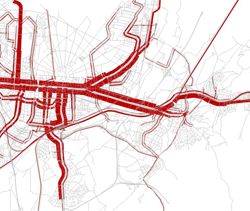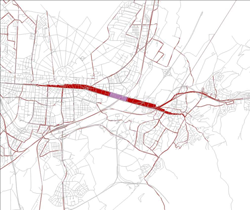Flow bundles are used to filter and graphically display loaded paths (obtained through assignment) according to various criteria. Loaded paths are the result of assignment calculation and are characterized by the following properties:
- They consist of a route path from an origin zone to a destination zone.
- They have a transport system type (PrT, PuT or PuT-Sys).
- The show a volume (passengers, vehicles).
Flow bundles consist of all paths traversing the network objects marked for flow bundle calculation. Marked network objects thus constitute the path filter criteria of a flow bundle. In the following section, you will learn about how to use the individual filter criteria. The Image 227 displays the principle of the flow bundle. The left figure shows all paths found in the assignment. The right figure shows the paths traversing the highlighted link.
|
|
|
|
All PrT paths (displayed as volume bars) |
Filtering of all PrT paths traversing the highlighted link by defining a flow bundle |
Image 227: The flow bundle as path filter
The flow bundle can be displayed graphically in the network editor (User Manual: Setting graphic parameters for the display of flow bundles) or output as a list (User Manual: Applying filters to lists). Using PuT assignment as an example, Image 228 displays the flow bundle paths in the PuT path legs list. In the graphical display, the path courses highlighted in color and the respective flow bundle volumes for each traversed link describe the spatial and quantitative distribution of traffic of the specified flow bundle.

Image 228: Display of the flow bundle paths in the PuT path leg list
|
Note: To display a flow bundle, you first have to calculate an assignment and save its paths. You can save paths in the PrT (User Manual: Settings for saving PrT assignment results) and in the PuT (User Manual: Settings for saving PuT assignment results). |
The flow bundle type is defined via the network object type selected:
- Node, main node, stop point, stop area, stop and sharing station flow bundle (selection of nodes, main nodes, stop points, stop areas, stops or sharing stations)
- Link flow bundle (highlighting links)
- Zone and main zone flow bundle (highlighting zones or main zones)
- Traffic type-based flow bundle (by setting specific links or network objects of the line hierarchy, i.e. lines, line routes, etc., passive)
The flow bundle can be created by highlighting one or more objects of a network object type. It can also be determined by any combination of highlighted network objects of different network object types (Combining flow bundle criteria).
|
Notes: If a flow bundle is active, its demand can be saved as a flow bundle matrix. The flow bundle considers the active settings of the OD pair filter. This allows you to perform flow bundle analyses that are additionally defined via a zone type (e.g. for internal zones only). |



